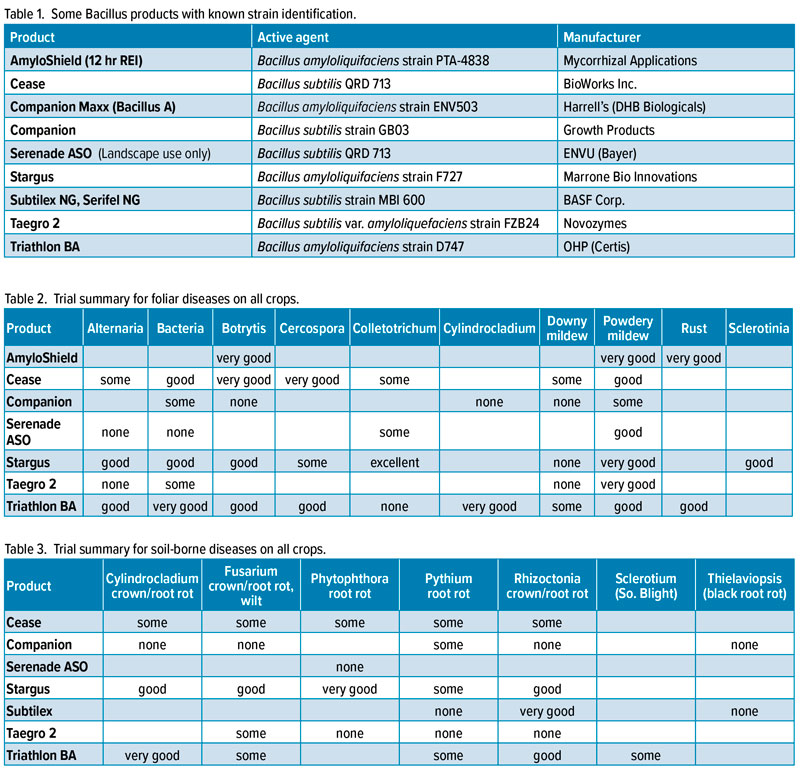4/1/2024
Bacillus-based Biopesticides
A.R. Chase

The first Bacillus-based biopesticide we worked on was originally called Rhapsody and is made from Bacillus subtilis QRD 713. We probably have more information on using Rhapsody/Cease for control of ornamental diseases than any of the other products created from strains of Bacillus subtilis or B. amyloliquifaciens.
Pictured: Botrytis blight on cyclamen.
Since OHP brought us Triathlon BA, we’ve worked on it in a wide variety of trials. Then we started to work on Stargus (Marrone BioInnovations) and most recently a number of newer or experimental products based on other strains of this bacterium.
Some of the products have been registered recently (AmyloShield), while the majority of products registered from this group have been liquid formulations. We’re now working on two different formulations, which are wettable powders, and another liquid formulation from Harrell’s.
Table 1 lists some of these products, including their exact strain and their manufacturers. Specific strain identification and strict product processes are critical. Each of the products I decided to include has a four-hour REI (except AmyloShield) and is OMRI-listed, making them user-friendly, especially for growers who produce edibles as well as ornamentals.
 Pictured: Powdery mildew on gerbera daisy.
Pictured: Powdery mildew on gerbera daisy.
Buying a product without a strain identification is a risk. Products that are strain-identified are more likely to produce reliable, consistent results. Just like conventional chemicals like strobilurins or sterol inhibitors are not interchangeable, not all Bacillus amyloliquifaciens/subtilis are the same. A large effort has been underway for over 40 years to determine how they work. The Bacillus strains in these products share many of the same features.
■ Antibiosis is the creation of anti-fungal metabolites. Some are created once the products are applied, but many of the current products are created during production of the product itself (lipopeptides, enzymes, siderophores and salicylicates). These products are effective in directly damaging the plant pathogens.
■ Competition by growing in the area a pathogen would normally occur crowds them out.
■ Induced resistance—many if not all of the effective Bacillus products stimulate the plant’s defense systems.
• Production of gibberellins and cytokinens that directly attack the fungal or bacterial pathogen or enhance plant growth.
• Promoting roots or seed germination can result in the plant outgrowing the damaging effects of soil-borne pathogenic fungi.
• Promoting plant resistance to toxic metabolites form fungi, increased photosynthesis and delayed senescence.
Trial efficacy summary
Some of these products work better on foliar diseases while others work better on soil-borne diseases. Some work better on bacterial leaf spots than the others. It would be impossible to choose a single product to cover the range of diseases one might encounter in ornamental production.
Table 2 and 3 summarize research trials with these Bacillus products on all crops (not just ornamentals). In some cases, the trials were primarily performed on edible crops, especially in Table 3. In others, a large number of trials have been conducted on ornamentals.
Finally, the fact that these are living organisms makes their full benefits dependent on more factors than use of a conventional fungicide or bactericide. It’s easier to affect a living organism with pH, salinity, temperature or even storage of the product than a conventional chemical.
Bacillus products can be very effective in a rotation with other biopesticides or conventional products. Some of their effects are based on the natural chemicals they create during their production. You can check manufacturer websites for compatibility of their Bacillus product with other effective choices for specific crops or diseases. Read the labels carefully! They usually include critical information on successful use of the product. The blanks indicate no trials that I could find.
In 2023, we performed four trials with AmyloShield: Botrytis blight on pansy, Botrytis blight on cyclamen, powdery mildew on gerbera daisy, and rust on snapdragon. Results are shown in Table 4. Products were applied once before inoculation (all trials) and then again on a weekly interval for powdery mildew and rust trials. Trials were conducted with different conventional standards, as well as Triathlon BA (1%) in each trial.
■ Botrytis trials had Astun (17 oz./100 gal.) and the disease rating for both Botrytis trials was the number of infected flowers.
■ The powdery mildew trial had Broadform (4 oz./100 gal.) with the disease rating for the powdery mildew trial was the number of powdery mildew colonies.
■ The rust trial had Terraguard (4 oz./100 gal.) and disease rating was number or pustules.
 Table 4. Disease severity with AmyloShield, conventional and Bacillus-based (Triathlon BA) standards. Higher bars show more disease.
Table 4. Disease severity with AmyloShield, conventional and Bacillus-based (Triathlon BA) standards. Higher bars show more disease.
Disease results showed that both rates of AmyloShield in both Botrytis trials, the powdery mildew trial and the rust trial were as effective as the standard. We did see some phytotoxicity in the gerbera daisy trial. Both rates of AmyloShield caused slight burning on leaves and flowers. This was not seen in any other trial. Check the product labels for legal use rates, application intervals and targets. Be sure to test all products for safety on your crops under your specific conditions.
Conclusions
Using Bacillus-based organic fungicide/bactericides can be as effective as conventional products for Botrytis, powdery mildew and rust. Many of the organic products currently available, as well as those in development, are proving to be an effective choice either in an organic program or in a conventional program. Even tank-mixtures with copper can work, although why use them together when an effective rotation is less costly?
Early testing with Cease and copper showed its tolerance (resistance) of copper was quite high. Read labels carefully to make sure you don’t try to make something work on a disease that the product isn’t labeled for. It’s always less costly to prevent a problem than to try to correct one. GT

A.R. Chase is with Chase Agricultural Consulting.